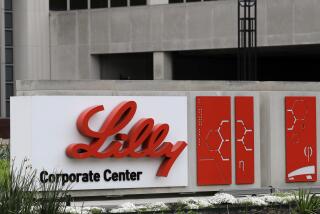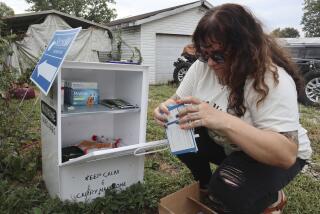Cancer drug Doxil joins growing list of drugs in short supply
A crucial cancer drug has been in short supply since midsummer — and its maker, Johnson & Johnson Inc., has not been able to remedy the situation since. The medicine, Doxil, is used to treat patients with ovarian cancer, multiple myeloma or Kaposi’s sarcoma after first-line treatments have failed.
In July, J&J’s Janssen division sent a letter to healthcare providers warning of the shortage and advised against prescribing it to new patients. In August, the drug company sent out another letter announcing a patient registry for Doxil so that they could wait in line, so to speak, for supplies of the drug as they became available.
Still, the manufacturing facility — Ben Venue Laboratories in Bedford, Ohio, which alone makes the world’s supply of Doxil — is not producing enough even for those patients already on the registry. Janssen spokeswoman Lisa Vaga says that there was “unplanned downtime due to equipment failure” and that the company has been working to line up another supplier in addition to getting the Ohio plant up to speed.
In the meantime, patients and their doctors are facing a tough situation. There’s no easy substitute for Doxil (also sold under the brand name Caelyx outside the U.S.).
“We know folks who are not getting the treatment that their doctors have recommended,” says Cara Tenenbaum, lead policy staffer at the Ovarian Cancer National Alliance, an advocacy group based in Washington, D.C.
Worse, there are patients who have faced recurrence of their cancer or failure of other cancer drugs.
Northe Olague of Tucson was diagnosed with ovarian cancer in 2004 and has undergone surgery and multiple chemotherapeutic regimens to keep her cancer at bay. Earlier this year, tests indicated that her cancer was growing again. Her doctor recommended Doxil.
But then, instead of getting her first monthly infusion, she learned that the drug was unavailable. “I was in disbelief,” Olague says.
“This is her last good option,” says her daughter, Taby Olague. Mother and daughter have been contacting everyone they can think of — Janssen, the Food and Drug Administration, their representatives. “I’m grateful for the seven years my mom has had, but she’s my mom, you know? You want the best chance, the best drug.”
Doxil is a special formulation of the drug doxorubicin, in which the active ingredient is encased in a fatty capsule so that it can hang around longer in the body. The capsule affects both how the drug attacks cancer cells and what side effects it has, says Dr. Michael Link, a Stanford University oncologist who is president of the American Society of Clinical Oncology, a professional society of cancer care providers.
Doxil is just one of 20-plus cancer drugs that are in shortage, Link says. “A lot of energy, time and investment goes into developing curative treatments [for cancer] — and now we can’t give it to patients, because there’s no drug. It’s unfathomable.”
About 200 medications are listed on the FDA’s drug shortage page. In addition to cancer drugs, the list includes anesthetics, sterile injectable drugs for conditions such as infection and heart conditions, and intravenous nutrition therapy. The agency lists only “medically necessary” drugs, not those for which substitute drugs are available.
The causes of drug shortages are not always clear. Sometimes manufacturing problems are to blame, as with Doxil, but economic issues also play a role. The supply chain for medicines encompasses many different players — manufacturers, distributors, hospital and retail pharmacies, and healthcare providers — making a complex web of business decisions that can result in a dearth of medicines for patients.
In the case of cancer drugs, oncologists typically sell them to patients directly instead of ordering them through a pharmacy. That arrangement gives the doctors an incentive to prescribe pricey brand-name drugs instead of inexpensive generic alternatives, according to an article published online this month in the New England Journal of Medicine. With demand for generics so low, many manufacturers have been forced to exit the market.
Managing drug shortages is expensive and time consuming for doctors. According to a report last month in the American Journal of Health-System Pharmacy, the extra labor involved adds up to $216 million a year.
The FDA has a drug shortage program that works with drug makers to manage supply problems. But the agency cannot force a company to make a drug.
Companies are required to give the FDA six months’ notice when they intend to stop making a drug that’s medically necessary and is not made by anyone else. And companies do report other supply problems to the agency voluntarily, as did J&J in the case of Doxil. Last year, 38 shortages were prevented because companies and the FDA worked together to come up with solutions, according to FDA spokeswoman Shelly Burgess.
Last month, President Obama signed an executive order directing the FDA to get companies to flag shortages even earlier, so there’s more time to figure out ways to work around them. Obama also ordered the FDA to speed up reviews of new manufacturing facilities and coordinate with the Justice Department to investigate cases of price gouging for drugs in high demand.
When a shortage does happen, ramping up supply again takes time, says Maya Birmingham, a lawyer for the Pharmaceutical Research and Manufacturers of America, a drug industry trade group in Washington, D.C. Any new manufacturing operation must meet certain quality control and regulatory requirements. When that is done, drug supplies are distributed based on existing contracts with providers, which means some doctors and hospitals will get drugs before others.
The FDA held a workshop in September with doctors, patient groups and drug company representatives to address the problem of drug shortages. “We don’t know the root cause, but we do know it’s having a detrimental effect on health,” says Tenenbaum, who represented the Ovarian Cancer National Alliance at the workshop. “It’s concerning about our system overall.”
No actions came out of the workshop; that’s because no one yet fully understands all the forces causing the problems, Link says. The American Society of Clinical Oncology is working to broadcast the urgency of the problem to the public and to Congress; last month, a member of the society testified before the U.S. House of Representatives Energy and Commerce Subcommittee on Health at a hearing examining the drug shortage crisis.
Until the problem is solved, patients bear the brunt, and many in desperation turn to the gray market — domestic or foreign sources that have stockpiled supplies of hard-to-get drugs.
“Sometimes drugs can be gotten through intermediaries or online pharmacies,” Tenenbaum says. It’s not illegal, but there are safety questions because buyers can’t be sure if the drug has been properly sourced and stored, she says. Also, many gray market suppliers sell at exorbitant prices, an issue that is getting the attention of U.S. legislators.
Northe Olague is considering gray market sources of Doxil. She reads online about other ovarian cancer patients who’ve gotten the drug from Vietnam and Britain. “That’s the only thing that keeps us alive,” she says.
More to Read
Inside the business of entertainment
The Wide Shot brings you news, analysis and insights on everything from streaming wars to production — and what it all means for the future.
You may occasionally receive promotional content from the Los Angeles Times.










